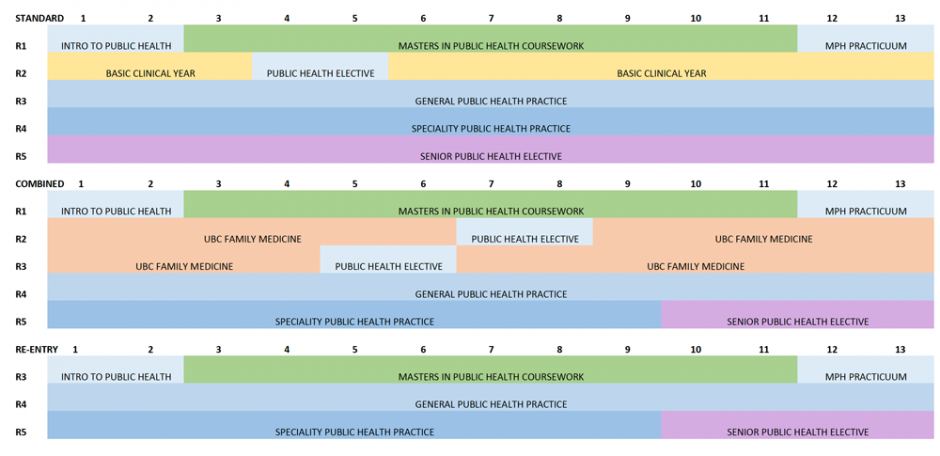
We acknowledge that the UBC Vancouver campus is situated on the traditional, ancestral, and unceded territory of the xʷməθkʷəy̓əm (Musqueam).
Program Pathway
Program Pathway

Your Program Pathway
The Public Health and Preventive Medicine (PHPM) Residency Program consists of learning activities and training experiences that support resident development across four stages of the CanMEDS Competency Continuum:
- Transition to Discipline (Junior resident)
- Foundation of Discipline (Junior resident)
- Core of Discipline (Senior resident)
- Transition to Practice (Senior/Fellow)
Program components that contribute to this continuum include an introduction to public health practice, academic training including research, clinical training in direct patient care, clinical training in public health practice, and elective sub-specialty training. Accordingly, the program meets the minimum requirements of the Royal College of Physicians and Surgeons of Canada.
Training Timeline
| Stage of Training | Program Component | Resident Role | PGY Year | Timeline |
| Transition to Discipline | Introduction to Public Health Practice | Junior | 1 | 2-3 months |
| Foundations of Discipline | Academic Training | Junior | 1 | 8-12 months |
| Foundations of Discipline | Direct Patient Care | Junior | 2-3 | 12-24 months |
| Core of Discipline | Public Health Practice | Senior | 3-4 | 18-24 months |
| Transition to Practice | Elective Subspecialty | Senior/Fellow | 4-5 | 6-12 months |
Program Schedule
Residency programs are based on four-week blocks, with 13 blocks per year. Clinical training in direct patient care typically occurs in 1-2 block rotations. Clinical training in public health practice typically occurs in 3-4 block rotations.
Sample Training Rotation

Training Pathways
Residents can choose either a standard PHPM pathway or a combined PHPM-FM pathway through the program. There is a re-entry option for physicians in current practice in Canada.
- Standard: five years, including one year of basic clinical training and one year of specialty public health elective
- Combined: five years, including two years of family practice training in UBC’s Family Medicine Program
- Re-Entry: three years in addition to current College of Family Physicians Canada (CFPC) or Royal College certification
Academic Training
As part of the program, residents must meet several academic requirements including graduate level coursework.
Basic Clinical Training
During their clinical training in direct patient care, residents have the option of completing a basic clinical year over a 12-month period or completing UBCs Family Medicine Program over a 24-month period.
Re-entry residents with certification from the CFPC or the Royal College are exempt from completing basic clinical training or the Family Medicine Program.
Public Health Practice
Over the course of the five-year program, residents must complete a minimum of 12 months of general public health practice and 12 months of subspecialty public health practice. In most cases, training experiences in general public health practice will include three 4-block rotations working with at least three of B.C.’s five regional health authorities. Training experiences in speciality public health practice will include three to five 2 to 4-block rotations drawing from a number of B.C. agencies that specialize in various aspects of public health and preventive medicine.
Elective Subspecialty Experience
Residents who have completed their general public health practice training and subspecialty training may use the remaining time in their program for elective or fellowship training experiences relevant to public health.
Research and Scholarship Opportunities
Residents are required to complete a scholarly project relevant to the practice of public health and preventive medicine. Over the course of the PHPM Residency Program, you will have many opportunities to become involved in academic activities, pursue research projects, and publish in both peer-reviewed journals and policy papers.